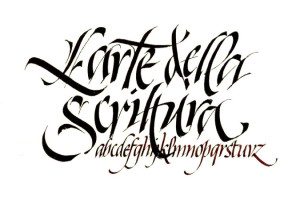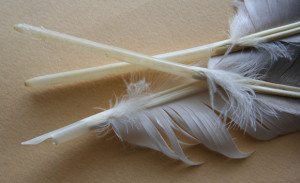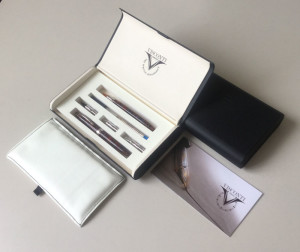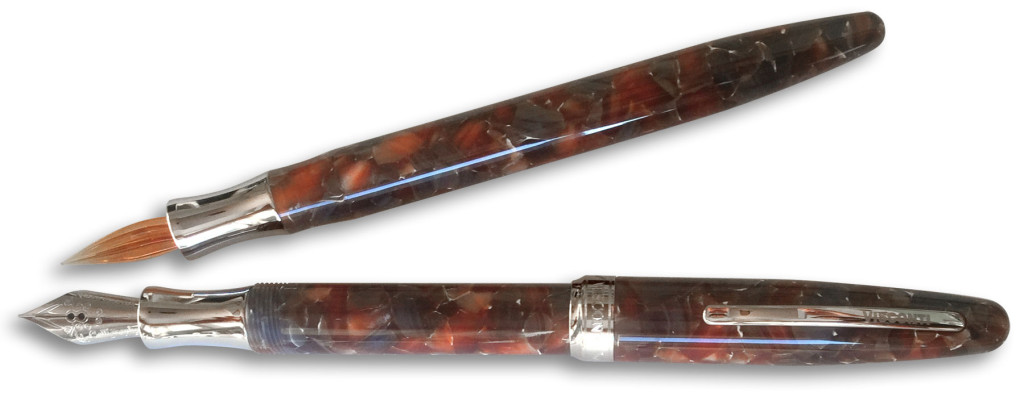 “Art of Writing” by Visconti summarizes two hundred years of writing styes with a single tool set devoted to the evolution of handwriting. The set includes five tools – from the simple metal nib to the cutting-edge tools of modern fountain pens. This is an incredible handwriting tool set that delivers the legacy of handwriting history directly into your hands. Availability is limited: order it now from Giardino.it.
“Art of Writing” by Visconti summarizes two hundred years of writing styes with a single tool set devoted to the evolution of handwriting. The set includes five tools – from the simple metal nib to the cutting-edge tools of modern fountain pens. This is an incredible handwriting tool set that delivers the legacy of handwriting history directly into your hands. Availability is limited: order it now from Giardino.it.
“There’s something special about writing by hand, writing with a fountain pen.”
Joe Haldeman
At the origins of writing
Writing is an expression of language by letters or other marks. Surprisingly enough, mankind originally started to write numbers – not letters – for the mere purpose of record keeping. This later developed into more complex systems to record human language. Such an exhaustive writing of language was invented independently in at least two places: in Mesopotamia, around 3200 BCE, and in Mesoamerica (Mexico), around 600 BCE.
Whatever the system, the greatest benefit of writing is that it provides the tool by which society can record information: writing allows societies to transmit information and share knowledge.
From the wedge to the letter
 One of the earliest forms of writing was the cuneiform system: in Mesopotamia, early logographs and pictographic symbols first evolved into more complex phonetics. However, in other areas, non-phonetic representation systems of language evolved through conceptual graphic symbols. Just think of Japanese, Chinese, or Hindu script.
One of the earliest forms of writing was the cuneiform system: in Mesopotamia, early logographs and pictographic symbols first evolved into more complex phonetics. However, in other areas, non-phonetic representation systems of language evolved through conceptual graphic symbols. Just think of Japanese, Chinese, or Hindu script.
The variety of human writing systems depends directly on people’s culture, philosophies and beliefs. Such systems – as opposed to phonetic writing systems – have been tied to handwriting for a longer period of time. This is due to the difficulty of transposing such symbols to a limited number of keys in computer keyboards.
When these complex shapes are not simplified, handwriting also requires a higher degree of expertise and artistic skills that involve the exploration of different writing tools and the refinement of the hand movement in order to produce different types of strokes.
Who invented pen and paper?
The earliest writing instruments that approached pen and paper, as we know them today, were invented by the Greek.
They used a stylus made of metal, bone or ivory, to inscribe marks on wax-coated tablets. Such tablets were paired in such a way to be closed to protect the scribe’s notes – making them the prototypes of modern note books. The Greek also invented the written letter, as we know it today: scholar Cadmus invented text messages written by hand on paper, sent from an individual to another.
The Chinese invented the ink, instead. This dye became of common use by the year 1200 BCE. The most common tool used to transfer ink on paper was the quill – a pen made from a bird feather.
How quills turned into fountain pens
 Quill pens were introduced around 700 CE and are the writing instrument that lasted for the longest period in history – over one thousand years.
Quill pens were introduced around 700 CE and are the writing instrument that lasted for the longest period in history – over one thousand years.
This, in spite of their drawbacks: quill pens lasted only one week before it was necessary to replace them. And this wasn’t the only disadvantage. (ed.: disadvantage? Well, it depends on your point of view… A new pen every week, wow!)
The strongest quills had to be taken from living birds during spring. The left wing was preferred because the feathers curved outwards and, hence, they facilitated the use for right-handed writers.
Goose feathers were the most common; swan feathers were the most expensive; while crow feathers were preferred to draw fine lines. Eagle, owl and hawk feathers were also used according to the current fashion.
The credit for the evolution of this system to fountain pens goes to the Italian: in 1495 CE, Venetian Aldus Manutius first invented the ‘running hand’. This is a cursive style composed of Roman capitals and small letters that inspired the improvement and perfecting of the writing tool to better fit the style.
However, the first patent for a fountain pen arrived only in 1884 by American Lewis Waterman. It was the beginning of modern handwriting.
Art of Writing by Visconti
 Visconti have gathered in a single box a set of handwriting tools that cover the evolution of the pen from the glass nib to gel refills. These tools will allow you to explore different handwriting styles and techniques through history and to elevate handwriting to an artistic level.
Visconti have gathered in a single box a set of handwriting tools that cover the evolution of the pen from the glass nib to gel refills. These tools will allow you to explore different handwriting styles and techniques through history and to elevate handwriting to an artistic level.
Each set includes:
a fountain pen,
a stiloforo (deskpen) and
five interchangeable sections, working by cartridges or refills (roller, rollergraphic, extraflex nib or firm stub nib) – with the exception of the glass nib, which needs to be dipped in ink.
Match the tool with the style
 The glass nib is a Thirties original, produced in Germany, and is suitable for extra-fine rigid writing.
The glass nib is a Thirties original, produced in Germany, and is suitable for extra-fine rigid writing.
If you fancy the complexity of gothic style, instead you can alternate fine and bold lines with the use of a single tool – the stub nib.
For a creative and smooth writing style in different ink colors, the rollergraphic will truly make a difference, instead.
For a classic style, use the ball point, featuring a cutting-edge refill with gel ink.
Finally, the extraflex nib is the optimal tool for English cursive and any other type of writing.
Available colors
Visconti have issued this amazing set in a wide range of bright and classic colors: here you can view all the pen colors originally issued by Visconti. Some of them were produced in extremely limited quantities, hence, many of them they are already sold out.
They are:
1: streaked Yellow
2: marbled Yellow/Brown
3: plain Orange
4: pearly Orange
5: streaked Green
6: plain Blue
7: pearly Green
8: marbled Amber/Blue
9: Titanic Blue
10: Kaleido Orange
11: marbled Blue
12: marbled Brown
13: Kaleido Green
14: night Blue
15: electric Blue
At the moment, Giardino Italiano is offering the Blue-and-Amber, Streaked-Green and Kaleido-Orange colors: if you want to be one of the lucky owners of Visconti’s box, secure your Art-of-Writing set now. 

 Go to www.giardino.it and start shopping immediately!
Go to www.giardino.it and start shopping immediately!
.
